Whether you mail order day old chicks from a hatchery, choose peeps from your local farm and feed store, or hatch eggs in an incubator, use these guidelines to raise chicks the first 6 weeks.
Raising chicks is a fun and rewarding project for anyone but for a homesteader, it’s also a necessity. Those baby chicks will be needed for the future production of eggs, meat, and garden fertilizer so taking proper care of them during the first 6 six weeks is crucial.

The easiest way to raise chicks is to let a broody hen do the work. That isn’t always ideal or even possible when first starting your flock. Instead, you will likely hatch eggs with an incubator, purchase day-old chicks to be delivered by mail, or pick up chicks at your neighborhood farm store. Shipping can be very stressful for the baby chicks, and they need your care to ensure their survival.
The first step to easing the transition is to get things set up before chicks arrive. Be sure to check out this article that explains what baby chicks need and how to prepare for your chicks’ arrival:
Then read on to learn what to expect and how to care for baby chicks for the first six weeks.
Baby Chicks’ Arrival Day
You are ready to pick up your chicks. The brooder is set up in a safe, warm area, away from drafts. You have checked the heat to be sure it is around 95˚F. You have your chick starter feed, chick feeders and waterers ready.
Now it is time to pick up the baby chicks and bring them home.
Preheat the Brooder
Baby chicks will usually be less than 3 days old when you get them and the little peeps will need to be placed immediately in a warm and secure environment. Turn the heat a few hours ahead of time so the brooder will heat up. If the brooder is outside in an outbuilding, it is crucial for the floor to be warm also. Baby chicks will not survive if their tiny feet are exposed to ice-cold floors.
Pickup the Chicks
Most feed stores have chick boxes on hand, but bring a clean box with you in case you need it. Cut several air holes in the top and close the top to prevent drafts and little chicks from escaping.
Expect the ride home to be noisy with your new chicks peeping away. If the weather is warm, keep the box closed, but place it on the floor out of direct sun. If the weather is cold, try to keep the chicks as warm by running the heater in your car. In addition, consider placing a small 12-volt heating pad in the bottom of the box and covering it with paper towels.
Place the Chicks into the Brooder
Place the box of chicks into the warm brooder and tip it to allow the chicks to fall gently into the brooder. Once the chicks are in the brooder, observe your little peeps to double check if the heat is right. If your chicks are huddled together under the heat, the brooder is too cold. If they are as far away from the heat lamp as possible, it is too warm. Make adjustments as needed so your chicks are comfortable.

Teach the Chicks to Drink and Eat
When a broody hen raises her chicks, she shows them how to scratch, eat, and drink. Since you are caring for the chicks, you will have to show them the way.
Just before chicks hatch, the egg yolk is absorbed into their bodies. This provides enough nourishment to the chick for about 48 hours after hatching. That is why day-old chicks can be shipped without food or water.
If you are picking up your chicks from a feed store, they have probably been introduced to food and water already. If you are retrieving your chicks from the post office or from the incubator, it is important to be sure they drink right away.
Place a shallow container filled with warm water in the brooder, away from the heat. Place the chicks around the water bowl and see whether they will drink on their own. If they don’t, pick them up, and dip their beaks into the water. Chicks should begin drinking once their beaks are wet. Place them back in the floor and they should drink on their own. If they don’t drink, dip their beaks in the water again.
Make sure each chick drinks some water. Wait about an hour, and then introduce food to them. Start chicks out with a chick starter food placed in a shallow container near the water bowl. Once they have found the water bowl, curiosity will compel them to check out the food container next to it and they will eat. Make sure each chick is drinking and eating.
The internal clock that regulates their sleep and wake cycle is not set yet, and they will eat and drink around the clock for the first few days. Provide continuous light for the initial 48 hours while the chicks adjust to the brooder and learn where to find food and water.
Let the Chicks Rest
Your baby chicks have had an adventurous 48 hours on their journey to you. Especially on the first day home, it is important that they are not over stimulated.
Your young flock will be noisy and run around chaotically at first, but should settle down once warmed under the heat lamp. Peek into the brooder to check on the chicks the first few hours, but try not to disturb them. They need time to rest and adjust to their new home.
Baby chicks can fall asleep in the blink of an eye. Don’t be alarmed if they just flop down and take a little nap. I was horrified the first time I saw this. I thought for sure my chicks were dying right before my very eyes. Thankfully, all was well….they were just sleepy chickies.
Day to Day Care for Baby Chicks
For the first few days, expect your baby chicks to sleep, eat, poop, and peep. The most crucial things for a baby chick’s survival are heat, water, and food…in that order. Your job is to make sure they are warm, replenish food and water as needed, and keep everything clean.
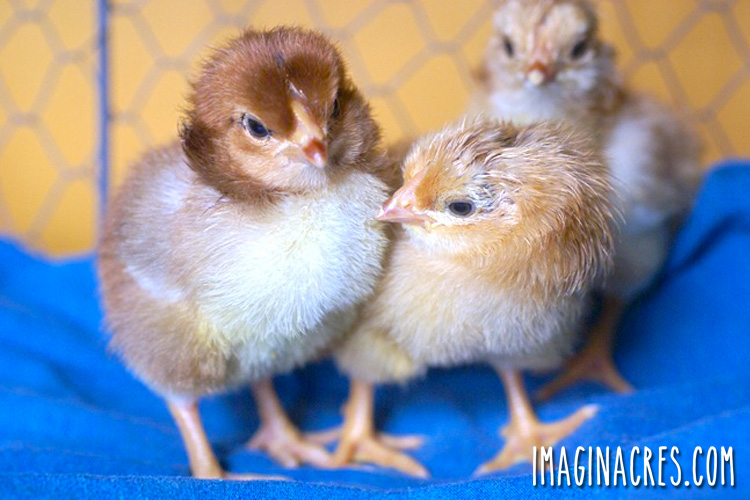
Keeping Chicks Warm
Maintain a temperature in the brooder that is around 90-95˚F for the first week. After the first week, lower the temperature by 5 degrees each week until it reaches 60˚F by the 6th week of the chicks’ life. Reduce the heat by adjusting the height of the brooder heater or by moving the heat lamp farther away from the brooder.
The chicks will let you know if they are too hot or too cold. If they are as far away from the heat lamp as they can get, or if their mouths are open and they’re panting, they are too hot. Decrease the temperature in the brooder. If the little peeps are huddled together under the heat, they are too cold and the brooder temperature needs to be increased.
Heat will be needed for the first six weeks, even if it is summertime. After 6 weeks, the heat can be turned off during the day and only used on chilly nights.
Food and Water
Transition from shallow containers to chick sized feeder and waterer and make sure food and water is available at all times.
Keeping the water clean will be challenging. Elevating the waterer on small blocks of wood will help prevent shavings from being kicked into the water. Change frequently to provide clean water for the baby chicks at all times.
Wash the waterer every day with hot soapy water and rinse well, and clean and scrub the feeders at least once a week.
Brooder Bedding
Once the baby chicks are eating and drinking, you can remove the paper towels covering the brooder bedding. Stir the bedding frequently and remove and replace soiled and wet shavings around the waterer. Eventually, you will need to change the bedding as needed to keep the brooder clean and dry.
Spend Time with Your Chicks
Spend time with your new baby chicks during the first 6 weeks so they will bond with you and become accustomed to your voice. You will be able to tell how they are doing by observing them and their behavior.
Talk to them while they are in the brooder allowing them to get accustomed to the sound of your voice. Use a certain repetitive phrase and scatter food on the floor so the chicks will associate the phrase with a tasty treat. The phrase can be anything just as long as it’s repeated every day. Teach your chicks to associate you with good things, and they will run to you when they get older as soon as you call for them.
After the chicks have rested for a few days, begin handling them for a few minutes a day. Before removing the chicks out of the brooder, wash your hands and wash your hands again after handling them. This will safeguard the peeps from germs that may be on your hands and protect you from salmonella.
Start with placing your hand in the brooder, so they can investigate. Add a bit of food and let them peck and eat out of the palm of your hand. Talk with them and repeat the phrase.
Pick up the chick by circling its body with your hand, with your fingers around the back of its body and your thumb across the front. Hold them lightly but securely to prevent them from jumping out of your hand and getting injured.
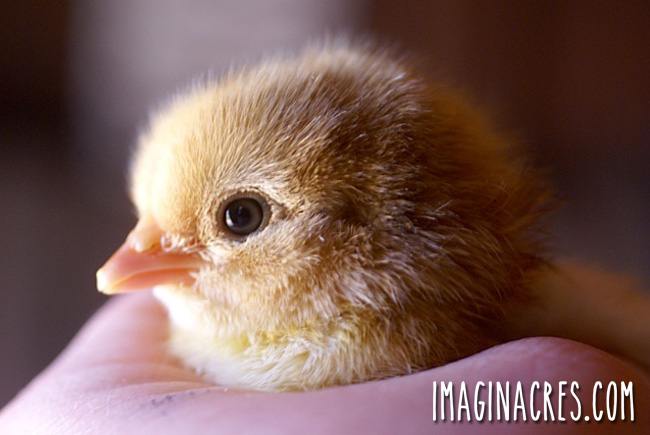
Watch them Grow!
By spending time with your baby chicks, you will see them grow quickly from fuzzy balls to pullets before your very eyes.
Tiny feathers begin to grow at the tips of the wings by the first few days! Tail feathers will soon follow within the first week. Each day the chicks will grow feathers in different areas making them look a bit funny. Their little bodies grow rapidly too.

By week 5, the chicks should have a full set of feathers and look like little chickens. Then they will molt, or lose their feathers and grow in new ones to accommodate their rapidly growing bodies. By week 6, the chicks will grow into pullets and should be fully feathered.
What to Watch For
Losing some baby chicks in the first week can be heartbreaking, but it is normal. The amount of loss depends on the amount of stress the chicks underwent during shipping. The mortality rate will be the highest in the first 48 hours. The chicks that survive those crucial first 48 hours typically will reach adulthood.
Check their fluffy butts: I know it’s a strange thing to say, but baby chicks can suffer from a preventable condition called, “pasty butt.” This occurs when the vent of the chick is blocked with dried poop. It’s often a side effect of stress and dehydration. Use a washcloth or cotton swab dipped in warm water to remove the poop.
Watch for aggressive behavior: Baby chicks may begin picking at each other if they are stressed, bored, too hot, or crowded. Adjust the environment as needed to keep the chicks happy.
Add a small roosting bar so they can practice roosting. Place chunks of grass and sod into the brooder for them to pick at. This will also introduce the chicks to grit, which is needed to help them digest food. Begin adding small amounts of vegetable scraps, such as lettuce for the chicks to dig through and keep them entertained.
——
Raising baby chicks is so much fun! You can allow baby chicks to go outdoors in a protected area after week six if they are fully feathered, you have a secure area, and the weather is warm enough. Young chicks are prime targets for all types of predators, including ground and aerial hunters, so their outside run area must be safe.
Be sure to have a coop or grow-out hutch ready to house your pullets when it is time for them to live outside.
Related Posts
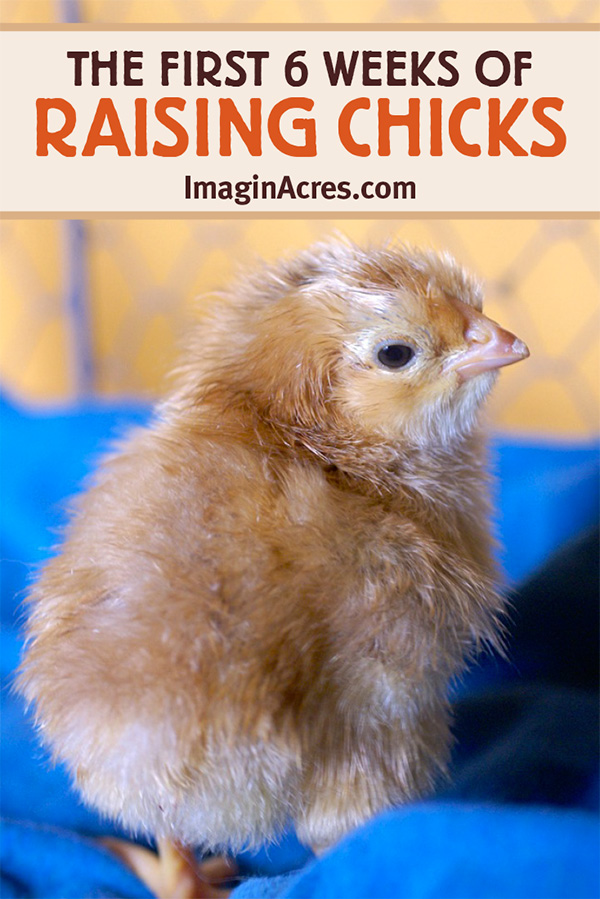

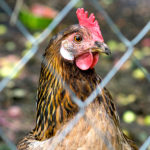
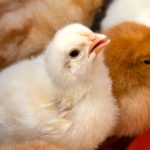



Leave a Reply